A Comprehensive Study of Tata Group: History, Challenges, Strategies
VerifiedAdded on 2023/06/12
|7
|1439
|92
Essay
AI Summary
This essay provides a detailed analysis of the Tata Group, tracing its history from its founding by Jamsetji Nusserwanji Tata to its current global presence. It highlights key milestones, including the establishment of Tata Steel and the leadership of Ratan Tata, which led to significant revenue growth and global expansion. The essay also examines the challenges faced by the Tata Group, such as building relationships between headquarters, portfolio issues, quality concerns, and leadership transitions. Furthermore, it discusses the current strategies employed by the company, including diversification, inorganic growth, backward integration, market exploration policies, and globalization, emphasizing their focus on technological development and rural area investment. The essay concludes by summarizing Tata Group's contributions to society through low-cost products, advanced technologies, and targeted rural development, acknowledging both its successes and the competitive pressures it faces.
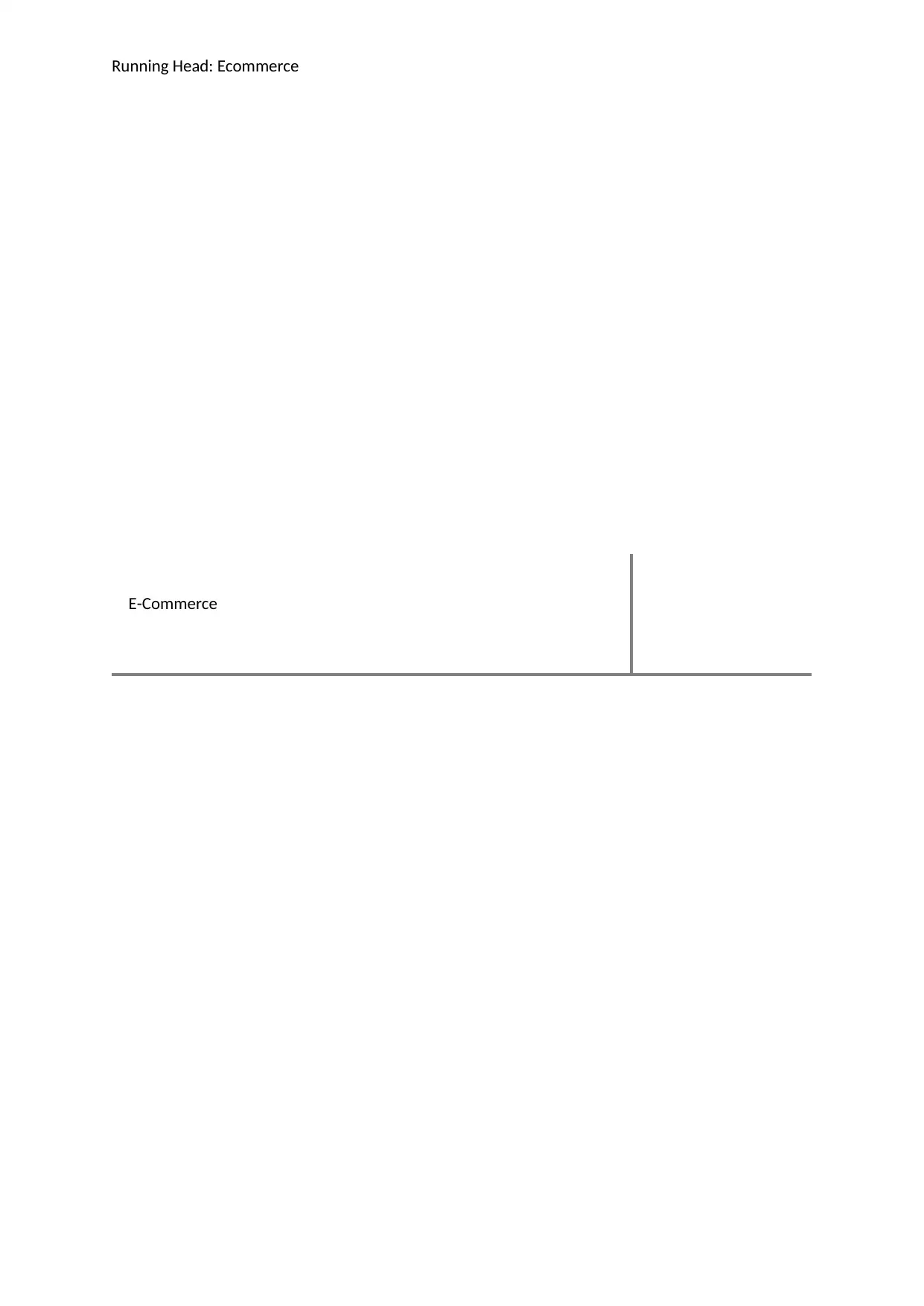
Running Head: Ecommerce
E-Commerce
E-Commerce
Paraphrase This Document
Need a fresh take? Get an instant paraphrase of this document with our AI Paraphraser
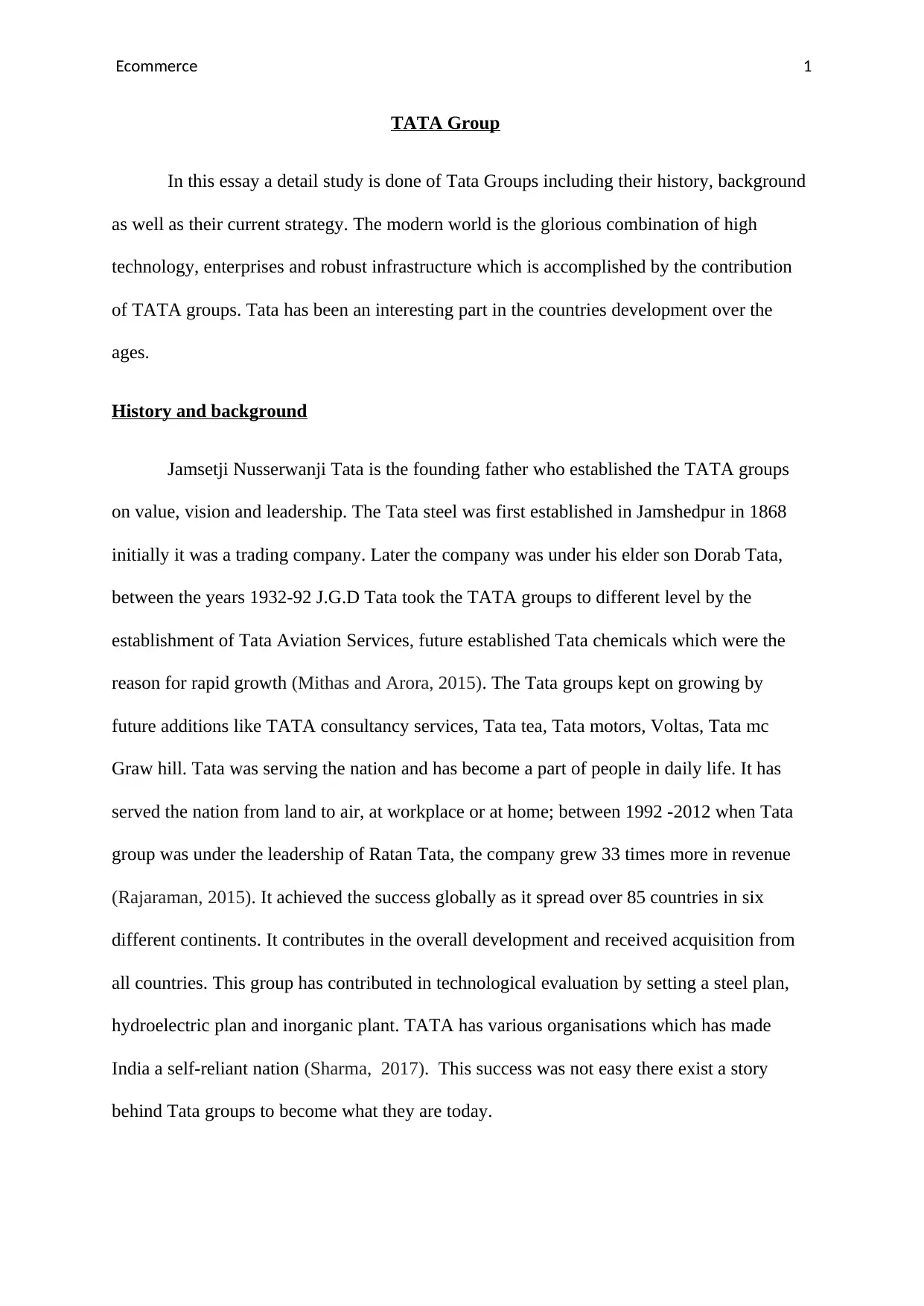
Ecommerce 1
TATA Group
In this essay a detail study is done of Tata Groups including their history, background
as well as their current strategy. The modern world is the glorious combination of high
technology, enterprises and robust infrastructure which is accomplished by the contribution
of TATA groups. Tata has been an interesting part in the countries development over the
ages.
History and background
Jamsetji Nusserwanji Tata is the founding father who established the TATA groups
on value, vision and leadership. The Tata steel was first established in Jamshedpur in 1868
initially it was a trading company. Later the company was under his elder son Dorab Tata,
between the years 1932-92 J.G.D Tata took the TATA groups to different level by the
establishment of Tata Aviation Services, future established Tata chemicals which were the
reason for rapid growth (Mithas and Arora, 2015). The Tata groups kept on growing by
future additions like TATA consultancy services, Tata tea, Tata motors, Voltas, Tata mc
Graw hill. Tata was serving the nation and has become a part of people in daily life. It has
served the nation from land to air, at workplace or at home; between 1992 -2012 when Tata
group was under the leadership of Ratan Tata, the company grew 33 times more in revenue
(Rajaraman, 2015). It achieved the success globally as it spread over 85 countries in six
different continents. It contributes in the overall development and received acquisition from
all countries. This group has contributed in technological evaluation by setting a steel plan,
hydroelectric plan and inorganic plant. TATA has various organisations which has made
India a self-reliant nation (Sharma, 2017). This success was not easy there exist a story
behind Tata groups to become what they are today.
TATA Group
In this essay a detail study is done of Tata Groups including their history, background
as well as their current strategy. The modern world is the glorious combination of high
technology, enterprises and robust infrastructure which is accomplished by the contribution
of TATA groups. Tata has been an interesting part in the countries development over the
ages.
History and background
Jamsetji Nusserwanji Tata is the founding father who established the TATA groups
on value, vision and leadership. The Tata steel was first established in Jamshedpur in 1868
initially it was a trading company. Later the company was under his elder son Dorab Tata,
between the years 1932-92 J.G.D Tata took the TATA groups to different level by the
establishment of Tata Aviation Services, future established Tata chemicals which were the
reason for rapid growth (Mithas and Arora, 2015). The Tata groups kept on growing by
future additions like TATA consultancy services, Tata tea, Tata motors, Voltas, Tata mc
Graw hill. Tata was serving the nation and has become a part of people in daily life. It has
served the nation from land to air, at workplace or at home; between 1992 -2012 when Tata
group was under the leadership of Ratan Tata, the company grew 33 times more in revenue
(Rajaraman, 2015). It achieved the success globally as it spread over 85 countries in six
different continents. It contributes in the overall development and received acquisition from
all countries. This group has contributed in technological evaluation by setting a steel plan,
hydroelectric plan and inorganic plant. TATA has various organisations which has made
India a self-reliant nation (Sharma, 2017). This success was not easy there exist a story
behind Tata groups to become what they are today.
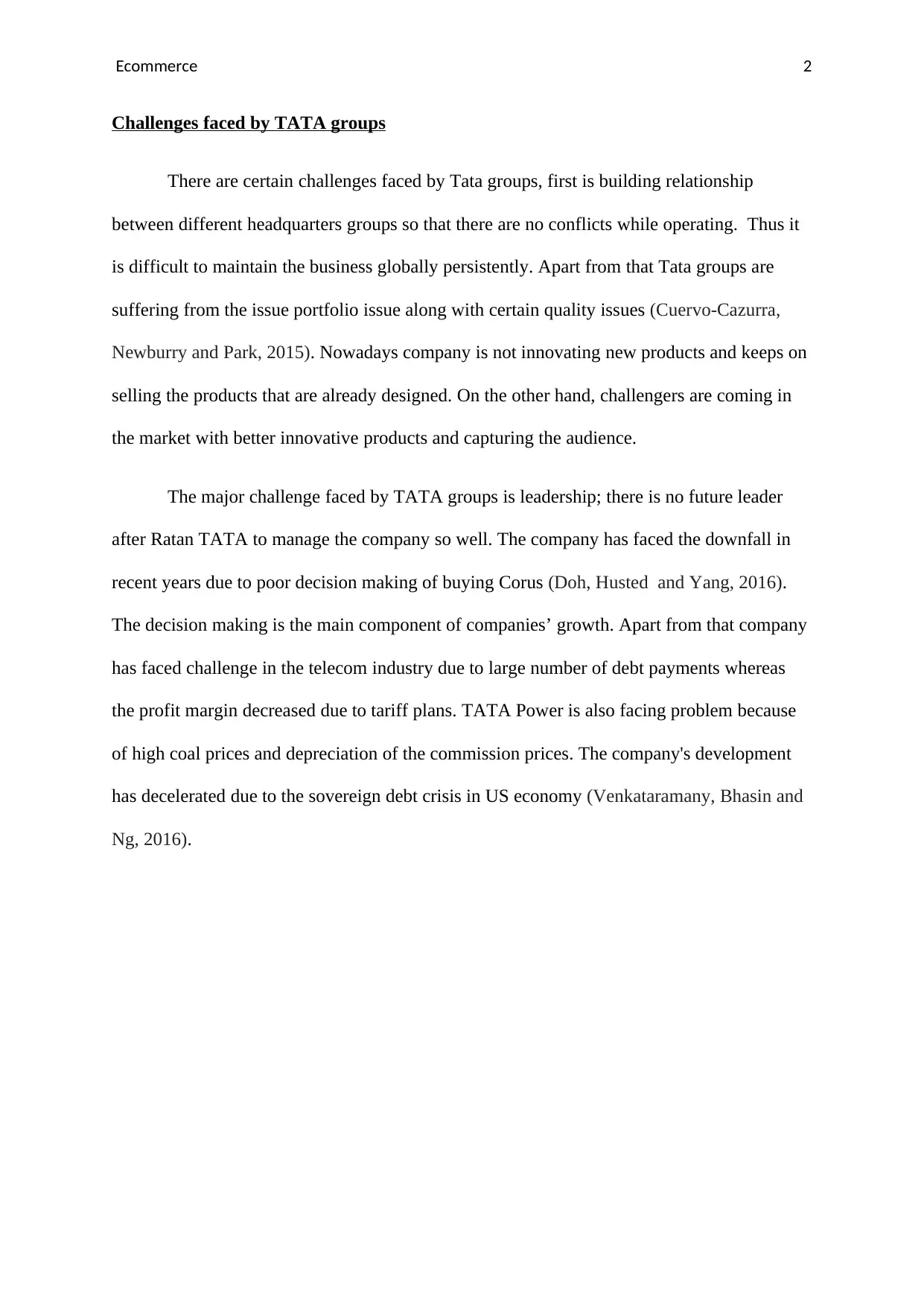
Ecommerce 2
Challenges faced by TATA groups
There are certain challenges faced by Tata groups, first is building relationship
between different headquarters groups so that there are no conflicts while operating. Thus it
is difficult to maintain the business globally persistently. Apart from that Tata groups are
suffering from the issue portfolio issue along with certain quality issues (Cuervo-Cazurra,
Newburry and Park, 2015). Nowadays company is not innovating new products and keeps on
selling the products that are already designed. On the other hand, challengers are coming in
the market with better innovative products and capturing the audience.
The major challenge faced by TATA groups is leadership; there is no future leader
after Ratan TATA to manage the company so well. The company has faced the downfall in
recent years due to poor decision making of buying Corus (Doh, Husted and Yang, 2016).
The decision making is the main component of companies’ growth. Apart from that company
has faced challenge in the telecom industry due to large number of debt payments whereas
the profit margin decreased due to tariff plans. TATA Power is also facing problem because
of high coal prices and depreciation of the commission prices. The company's development
has decelerated due to the sovereign debt crisis in US economy (Venkataramany, Bhasin and
Ng, 2016).
Challenges faced by TATA groups
There are certain challenges faced by Tata groups, first is building relationship
between different headquarters groups so that there are no conflicts while operating. Thus it
is difficult to maintain the business globally persistently. Apart from that Tata groups are
suffering from the issue portfolio issue along with certain quality issues (Cuervo-Cazurra,
Newburry and Park, 2015). Nowadays company is not innovating new products and keeps on
selling the products that are already designed. On the other hand, challengers are coming in
the market with better innovative products and capturing the audience.
The major challenge faced by TATA groups is leadership; there is no future leader
after Ratan TATA to manage the company so well. The company has faced the downfall in
recent years due to poor decision making of buying Corus (Doh, Husted and Yang, 2016).
The decision making is the main component of companies’ growth. Apart from that company
has faced challenge in the telecom industry due to large number of debt payments whereas
the profit margin decreased due to tariff plans. TATA Power is also facing problem because
of high coal prices and depreciation of the commission prices. The company's development
has decelerated due to the sovereign debt crisis in US economy (Venkataramany, Bhasin and
Ng, 2016).
⊘ This is a preview!⊘
Do you want full access?
Subscribe today to unlock all pages.

Trusted by 1+ million students worldwide
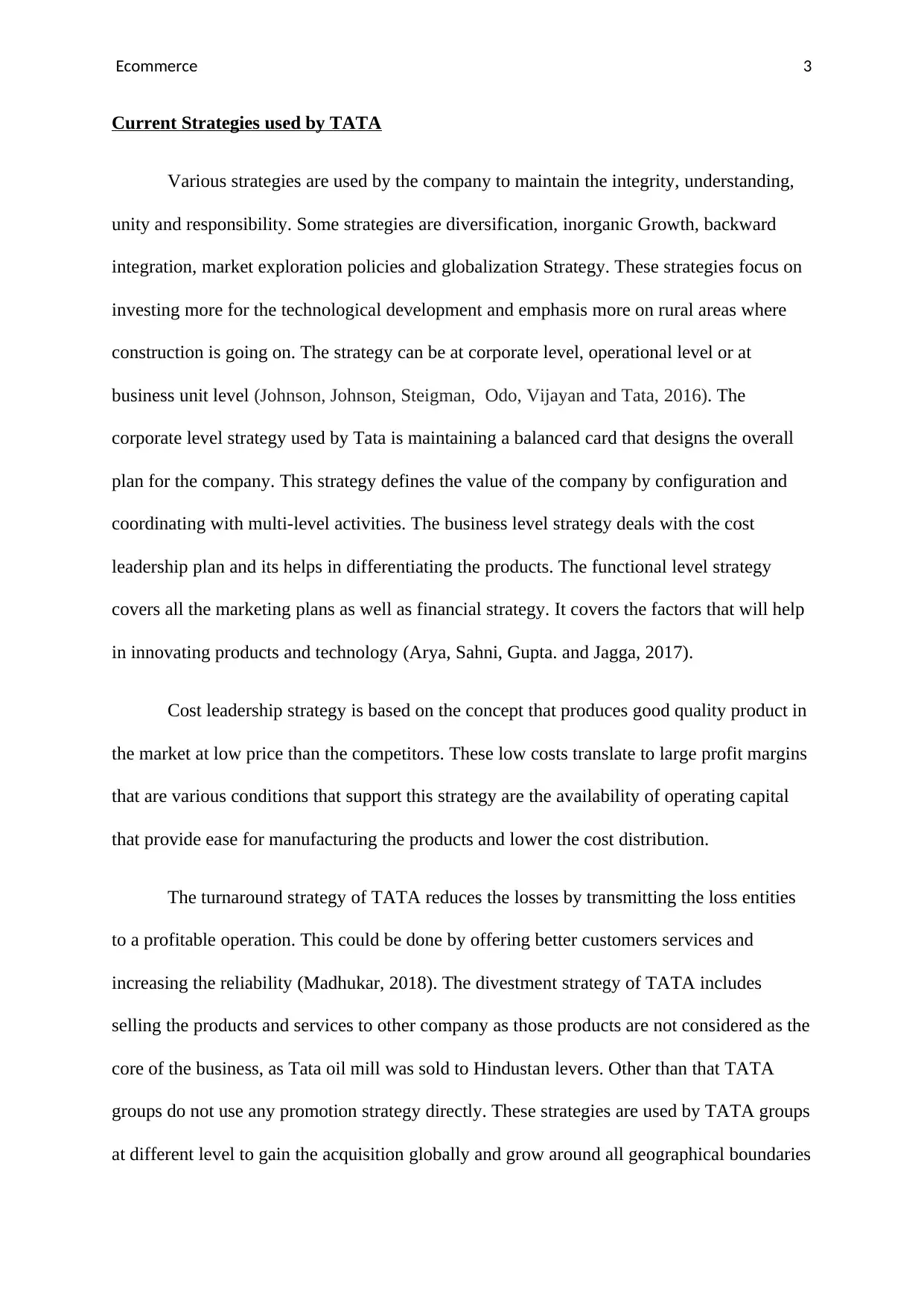
Ecommerce 3
Current Strategies used by TATA
Various strategies are used by the company to maintain the integrity, understanding,
unity and responsibility. Some strategies are diversification, inorganic Growth, backward
integration, market exploration policies and globalization Strategy. These strategies focus on
investing more for the technological development and emphasis more on rural areas where
construction is going on. The strategy can be at corporate level, operational level or at
business unit level (Johnson, Johnson, Steigman, Odo, Vijayan and Tata, 2016). The
corporate level strategy used by Tata is maintaining a balanced card that designs the overall
plan for the company. This strategy defines the value of the company by configuration and
coordinating with multi-level activities. The business level strategy deals with the cost
leadership plan and its helps in differentiating the products. The functional level strategy
covers all the marketing plans as well as financial strategy. It covers the factors that will help
in innovating products and technology (Arya, Sahni, Gupta. and Jagga, 2017).
Cost leadership strategy is based on the concept that produces good quality product in
the market at low price than the competitors. These low costs translate to large profit margins
that are various conditions that support this strategy are the availability of operating capital
that provide ease for manufacturing the products and lower the cost distribution.
The turnaround strategy of TATA reduces the losses by transmitting the loss entities
to a profitable operation. This could be done by offering better customers services and
increasing the reliability (Madhukar, 2018). The divestment strategy of TATA includes
selling the products and services to other company as those products are not considered as the
core of the business, as Tata oil mill was sold to Hindustan levers. Other than that TATA
groups do not use any promotion strategy directly. These strategies are used by TATA groups
at different level to gain the acquisition globally and grow around all geographical boundaries
Current Strategies used by TATA
Various strategies are used by the company to maintain the integrity, understanding,
unity and responsibility. Some strategies are diversification, inorganic Growth, backward
integration, market exploration policies and globalization Strategy. These strategies focus on
investing more for the technological development and emphasis more on rural areas where
construction is going on. The strategy can be at corporate level, operational level or at
business unit level (Johnson, Johnson, Steigman, Odo, Vijayan and Tata, 2016). The
corporate level strategy used by Tata is maintaining a balanced card that designs the overall
plan for the company. This strategy defines the value of the company by configuration and
coordinating with multi-level activities. The business level strategy deals with the cost
leadership plan and its helps in differentiating the products. The functional level strategy
covers all the marketing plans as well as financial strategy. It covers the factors that will help
in innovating products and technology (Arya, Sahni, Gupta. and Jagga, 2017).
Cost leadership strategy is based on the concept that produces good quality product in
the market at low price than the competitors. These low costs translate to large profit margins
that are various conditions that support this strategy are the availability of operating capital
that provide ease for manufacturing the products and lower the cost distribution.
The turnaround strategy of TATA reduces the losses by transmitting the loss entities
to a profitable operation. This could be done by offering better customers services and
increasing the reliability (Madhukar, 2018). The divestment strategy of TATA includes
selling the products and services to other company as those products are not considered as the
core of the business, as Tata oil mill was sold to Hindustan levers. Other than that TATA
groups do not use any promotion strategy directly. These strategies are used by TATA groups
at different level to gain the acquisition globally and grow around all geographical boundaries
Paraphrase This Document
Need a fresh take? Get an instant paraphrase of this document with our AI Paraphraser
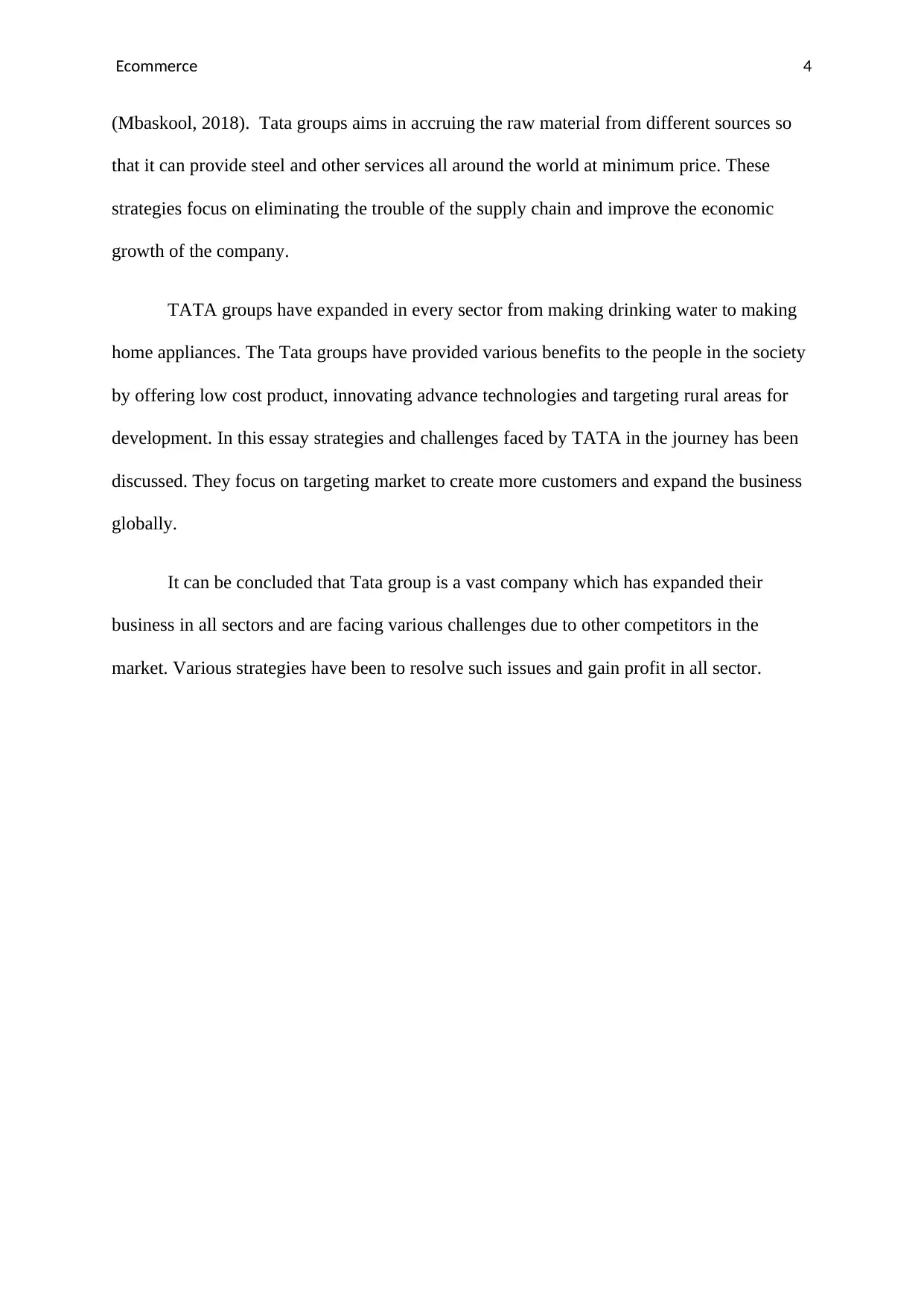
Ecommerce 4
(Mbaskool, 2018). Tata groups aims in accruing the raw material from different sources so
that it can provide steel and other services all around the world at minimum price. These
strategies focus on eliminating the trouble of the supply chain and improve the economic
growth of the company.
TATA groups have expanded in every sector from making drinking water to making
home appliances. The Tata groups have provided various benefits to the people in the society
by offering low cost product, innovating advance technologies and targeting rural areas for
development. In this essay strategies and challenges faced by TATA in the journey has been
discussed. They focus on targeting market to create more customers and expand the business
globally.
It can be concluded that Tata group is a vast company which has expanded their
business in all sectors and are facing various challenges due to other competitors in the
market. Various strategies have been to resolve such issues and gain profit in all sector.
(Mbaskool, 2018). Tata groups aims in accruing the raw material from different sources so
that it can provide steel and other services all around the world at minimum price. These
strategies focus on eliminating the trouble of the supply chain and improve the economic
growth of the company.
TATA groups have expanded in every sector from making drinking water to making
home appliances. The Tata groups have provided various benefits to the people in the society
by offering low cost product, innovating advance technologies and targeting rural areas for
development. In this essay strategies and challenges faced by TATA in the journey has been
discussed. They focus on targeting market to create more customers and expand the business
globally.
It can be concluded that Tata group is a vast company which has expanded their
business in all sectors and are facing various challenges due to other competitors in the
market. Various strategies have been to resolve such issues and gain profit in all sector.
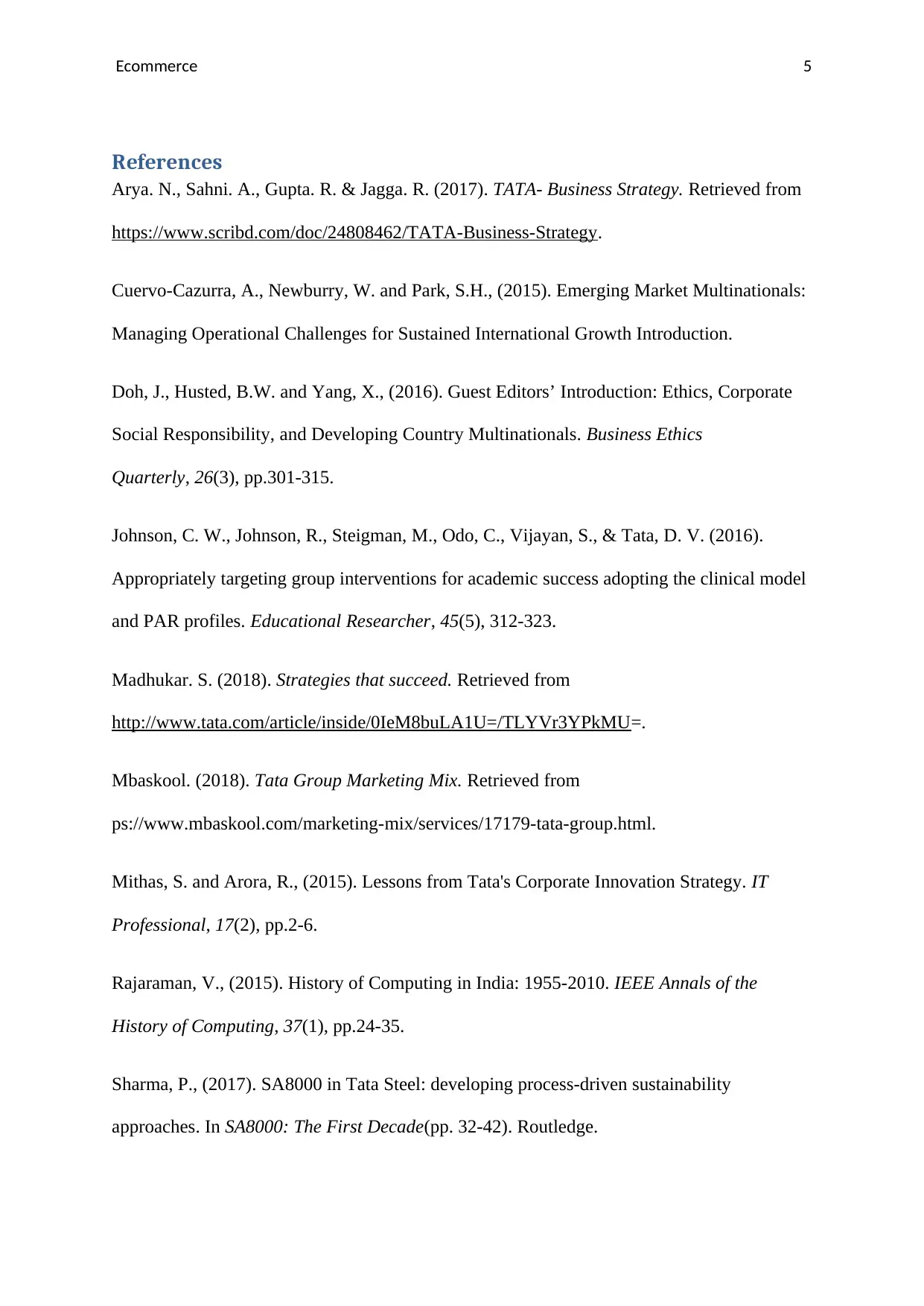
Ecommerce 5
References
Arya. N., Sahni. A., Gupta. R. & Jagga. R. (2017). TATA- Business Strategy. Retrieved from
https://www.scribd.com/doc/24808462/TATA-Business-Strategy.
Cuervo-Cazurra, A., Newburry, W. and Park, S.H., (2015). Emerging Market Multinationals:
Managing Operational Challenges for Sustained International Growth Introduction.
Doh, J., Husted, B.W. and Yang, X., (2016). Guest Editors’ Introduction: Ethics, Corporate
Social Responsibility, and Developing Country Multinationals. Business Ethics
Quarterly, 26(3), pp.301-315.
Johnson, C. W., Johnson, R., Steigman, M., Odo, C., Vijayan, S., & Tata, D. V. (2016).
Appropriately targeting group interventions for academic success adopting the clinical model
and PAR profiles. Educational Researcher, 45(5), 312-323.
Madhukar. S. (2018). Strategies that succeed. Retrieved from
http://www.tata.com/article/inside/0IeM8buLA1U=/TLYVr3YPkMU=.
Mbaskool. (2018). Tata Group Marketing Mix. Retrieved from
ps://www.mbaskool.com/marketing-mix/services/17179-tata-group.html.
Mithas, S. and Arora, R., (2015). Lessons from Tata's Corporate Innovation Strategy. IT
Professional, 17(2), pp.2-6.
Rajaraman, V., (2015). History of Computing in India: 1955-2010. IEEE Annals of the
History of Computing, 37(1), pp.24-35.
Sharma, P., (2017). SA8000 in Tata Steel: developing process-driven sustainability
approaches. In SA8000: The First Decade(pp. 32-42). Routledge.
References
Arya. N., Sahni. A., Gupta. R. & Jagga. R. (2017). TATA- Business Strategy. Retrieved from
https://www.scribd.com/doc/24808462/TATA-Business-Strategy.
Cuervo-Cazurra, A., Newburry, W. and Park, S.H., (2015). Emerging Market Multinationals:
Managing Operational Challenges for Sustained International Growth Introduction.
Doh, J., Husted, B.W. and Yang, X., (2016). Guest Editors’ Introduction: Ethics, Corporate
Social Responsibility, and Developing Country Multinationals. Business Ethics
Quarterly, 26(3), pp.301-315.
Johnson, C. W., Johnson, R., Steigman, M., Odo, C., Vijayan, S., & Tata, D. V. (2016).
Appropriately targeting group interventions for academic success adopting the clinical model
and PAR profiles. Educational Researcher, 45(5), 312-323.
Madhukar. S. (2018). Strategies that succeed. Retrieved from
http://www.tata.com/article/inside/0IeM8buLA1U=/TLYVr3YPkMU=.
Mbaskool. (2018). Tata Group Marketing Mix. Retrieved from
ps://www.mbaskool.com/marketing-mix/services/17179-tata-group.html.
Mithas, S. and Arora, R., (2015). Lessons from Tata's Corporate Innovation Strategy. IT
Professional, 17(2), pp.2-6.
Rajaraman, V., (2015). History of Computing in India: 1955-2010. IEEE Annals of the
History of Computing, 37(1), pp.24-35.
Sharma, P., (2017). SA8000 in Tata Steel: developing process-driven sustainability
approaches. In SA8000: The First Decade(pp. 32-42). Routledge.
⊘ This is a preview!⊘
Do you want full access?
Subscribe today to unlock all pages.

Trusted by 1+ million students worldwide
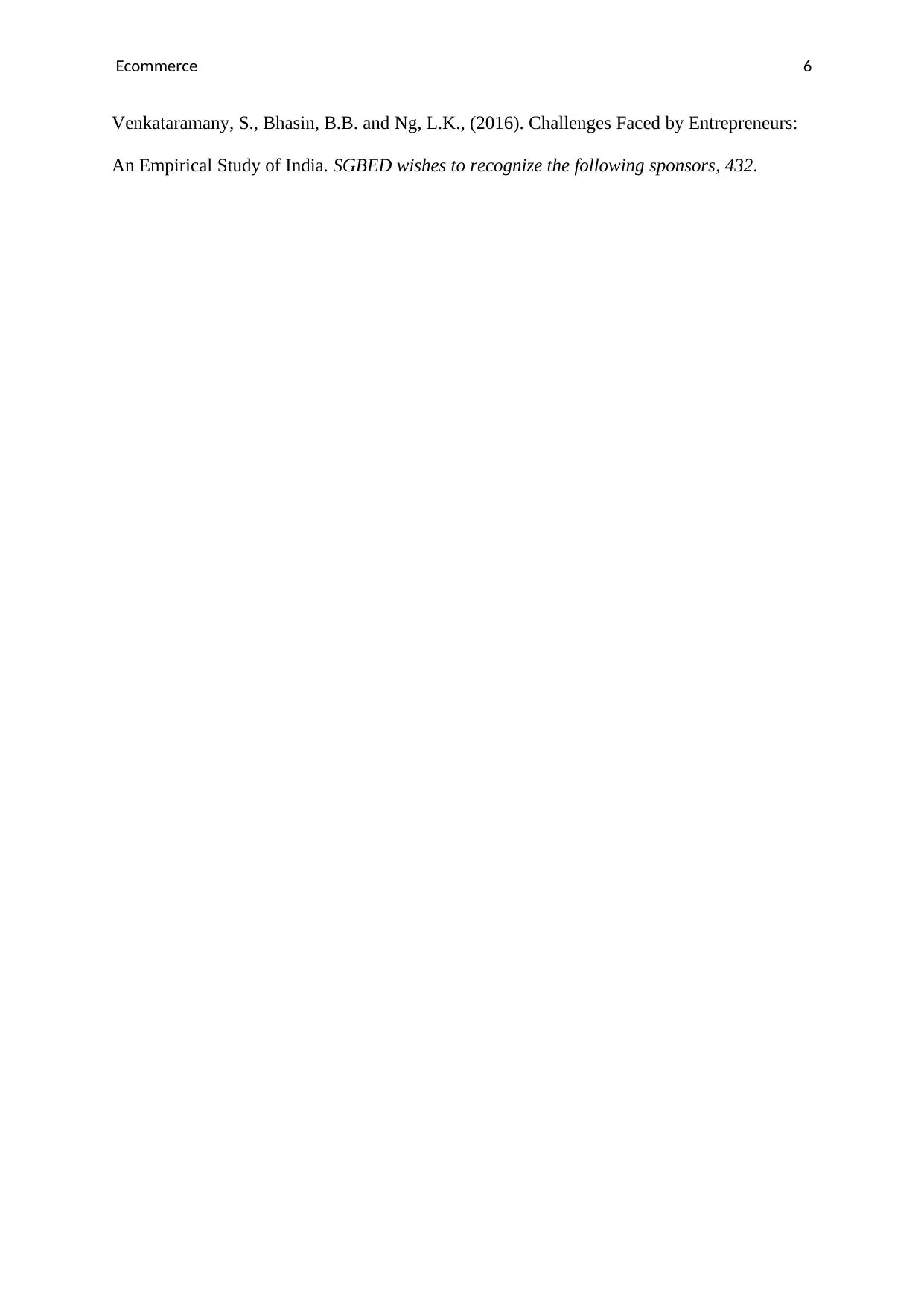
Ecommerce 6
Venkataramany, S., Bhasin, B.B. and Ng, L.K., (2016). Challenges Faced by Entrepreneurs:
An Empirical Study of India. SGBED wishes to recognize the following sponsors, 432.
Venkataramany, S., Bhasin, B.B. and Ng, L.K., (2016). Challenges Faced by Entrepreneurs:
An Empirical Study of India. SGBED wishes to recognize the following sponsors, 432.
1 out of 7
Related Documents
Your All-in-One AI-Powered Toolkit for Academic Success.
+13062052269
info@desklib.com
Available 24*7 on WhatsApp / Email
![[object Object]](/_next/static/media/star-bottom.7253800d.svg)
Unlock your academic potential
Copyright © 2020–2025 A2Z Services. All Rights Reserved. Developed and managed by ZUCOL.





